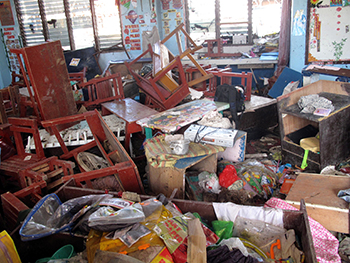 When a serious flood, earthquake or other natural disaster occurs in a particular area, the effects are often devastating. Entire neighborhoods are destroyed. Buildings collapse. People are injured or even killed. Part of what makes natural disasters so powerful is that no one knows when they’ll occur. While you can’t predict when an earthquake will strike, you can prepare for it by making your school more resilient to natural disasters. With this being said, it is not just schools that need to be prepared for situations like this. It is everyone. Whether you live alone or have a large family, it is always best to have a plan B. These nothing worse than knowing you’re not prepared. This is why something like a bug out bag is essential. You can’t be anymore ready than having all your items for survival in one bag, ready to go!
When a serious flood, earthquake or other natural disaster occurs in a particular area, the effects are often devastating. Entire neighborhoods are destroyed. Buildings collapse. People are injured or even killed. Part of what makes natural disasters so powerful is that no one knows when they’ll occur. While you can’t predict when an earthquake will strike, you can prepare for it by making your school more resilient to natural disasters. With this being said, it is not just schools that need to be prepared for situations like this. It is everyone. Whether you live alone or have a large family, it is always best to have a plan B. These nothing worse than knowing you’re not prepared. This is why something like a bug out bag is essential. You can’t be anymore ready than having all your items for survival in one bag, ready to go!
Because unexpected tragedies happen globally every year, it’s important for schools — from elementary schools to universities — to take steps to prepare their campus infrastructure. For example, Typhoon Haiyan damaged more than 2,500 schools and affected 1.4 million children in the Philippines in 2013, according to the World Bank. Additionally, recent floods in Malawi affected hundreds of schools, disrupting the education of more than 350,000 children. What is clear from these statistics is that schools are vulnerable.
There are several different ways to look at resilience, according to the United Nations Economic and Social Commission for Asia and the Pacific (ESCAP). However, a common element among definitions is the idea that recovery in a changing environment requires the capacity to withstand, absorb and adapt to shocks. For schools in various parts of the country, becoming better able to withstand disasters and adapt to shocks means being proactive to prepare infrastructure, now.
With that in mind, here are three ways to make K-12 and university buildings more resilient to natural disasters:
1. Identify Vulnerabilities
The Organization for American States (OAS) suggests that assessing risks and hazards is an important first step in improving school resilience. Less vulnerable structures mean protected investments, longer building lifespans and greater safety for students and teachers. Through the collection of basic structural and physical information of all structures, including details of location, and the analysis of data with regard to the ability to resist the effect of specific natural and manmade hazards, school officials can at least gain an idea of what risks and hazards exist. Consider what types of natural disasters are possible in your geographic area, and how the school’s structures would withstand those disasters if they occurred. The answers to these questions provide a valuable starting point in improving school preparedness.
2. Strengthen and Protect Buildings
Once you’ve assessed the most vulnerable areas of your structures, you have a good idea of what needs to change. Prioritize tasks based on what is most important to your school. Does the building where students spend the most time have glaring structural issues that would make it vulnerable to storm damage? Start there. Use funds to invest in projects that will add security and stability to your school. You may also wish to work with a disaster restoration contractor that can professionally evaluate your structures and offer solutions.
3. Understand Safe Construction
Along with increasing safety and security, the first two steps offer the added benefit of informing future building projects. Once you’ve seen where safety concerns exist in your current structures, it’s clearer how you can avoid those issues in new buildings. “Understanding what factors are driving unsafe construction practices will enable decision-makers to make targeted adjustments to planned investments to ensure the quality of new construction and avoid the creation of new risk, according to the World Bank. Likewise, understanding what vulnerabilities you’re facing may also warrant building emergency shelters of some kind.
As Vice President of Operations for DKI Commercial Solutions, Bill Robinson oversees disaster relief operations for commercial large loss in the U.S. DKI Services is a remediation and restoration company that offers emergency restoration services for residential and commercial buildings.

